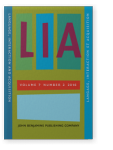Laia Arnaus Gil
List of John Benjamins publications for which Laia Arnaus Gil plays a role.
Articles
2020 Acceleration and delay in bilingual, trilingual and multilingual German-Romance children: Finite verb placement in German Linguistic Approaches to Bilingualism 10:4, pp. 530–558 | Article
A production test with 91 bilingual, trilingual and multilingual children (who acquire more than three languages) elicited finite verbs in German. In comparison with monolinguals, the children were accelerated with respect to finite verb placement in main clauses. Following Biberauer & Richards… read more
2018 The acquisition of variation: Romance adjective placement in bilingual children Romance Languages and Linguistic Theory 13: Selected papers from ‘Going Romance’ 29, Nijmegen, Berns, Janine, Haike Jacobs and Dominique Nouveau (eds.), pp. 143–158 | Chapter
Bilingual children do not have problems with variation across languages, one of the most convincing kind of evidence that they are able to separate their two languages from early on. Natural languages exhibit another kind of variation, namely intra-linguistic variation, as in the case of adjective… read more
2016 Mélanges interpropositionnels chez les enfants bilingues franco-allemands: Est-ce vraiment du code-switching ? Language, Interaction and Acquisition 7:2, pp. 238–274 | Article
The literature on the mixing of two languages in children bilingual from birth distinguishes code switching on different levels, switching within the same sentence or utterance (‘intra-sentential switching’, ‘intra-utterance switching’ following Genesee, Boivin & Nicoladis, 1996 : 428–429) and… read more
2015 The acquisition of Spanish in a bilingual and a trilingual L1 setting: Combining Spanish with German, French and Catalan The Acquisition of Spanish in Understudied Language Pairings, Judy, Tiffany and Silvia Perpiñán (eds.), pp. 135–168 | Article
This study focuses on the early acquisition of Spanish predicative adjectives accompanied with copula selection and the position of attributive adjectives in longitudinal data from simultaneous Spanish-German and Spanish-French bilinguals and from Spanish-Catalan-German trilingual children. As for… read more



